Radtour Bilbao - Kap Finisterre
Geplante Tour: Camino de Santiago de la Costa/Camino de Santiago a Finisterre
Aktionen
![]()
Bitte warten - Kartendaten werden geladen
Erstellt am 07.02.2014,
am 11.05.2016
Aktionen
Strecken-Merkmale
geplant
gefahren
Gesamtlänge in km
778
0
Gesamthöhenmeter Aufstieg
16.163
0
Durchschn. Steigung Aufstieg %
2,08
-
Gesamthöhenmeter Abstieg
16.077
0
Informationen zu Rechten an den GPS-Track-Daten | |
|---|---|
Rechte-Inhaber | Openstreetmap and Contributors + biroto-Redaktion (biroto.eu) |
Rechte-Ausprägung / Lizenz | Enthält Daten von OpenStreetMap, die hier unter der Open Database License(ODbL) verfügbar gemacht werden |
Link zur Rechtebeschreibung | |
gpx-Datei übernommen aus | |
gpx-Datei hochgeladen | durch biroto-Redaktion am 14.02.2014
|
Gesamtzahl Trackpoints
15.156
0
Trackpoint-Dichte per km
19
0
Endorte
Start
Bilbao, País Vasco, ES (28 m NHN)
Ziel
Finisterre, Galicia, ES (114 m NHN)
Fahrradfreundliche Unterkünfte, Sehenswertes und Infrastruktur
Name u. Anschrift
Breite / Länge
Tel.
Fax.
Mobile
Art d. Unterkunft
Radler-freund-lichkeit
Strecken-km
km zur Strecke
Höhe
0 km
0,0 km
25 m
0 km
0,5 km
19 m
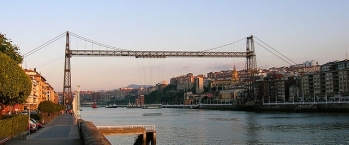
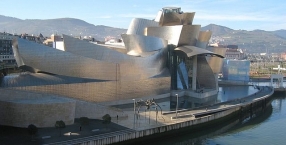

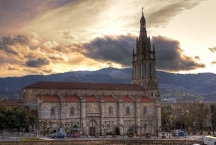
Bilbao (bask. auch Bilbo) ist die Hauptstadt der Provinz Bizkaia (spanisch: Vizcaya
) und größte Stadt der Autonomen Gemeinschaft Baskenland in Spanien.
Weiter ist sie die wichtigste Industrie- und Hafenstadt des Baskenlands und hat zuzüglich des Umlands fast 900.000 Einwohner. Mit 349.356 Einwohnern im Stadtgebiet ist Bilbao eine der zehn größten Städte Spaniens.
Sehenswürdigkeiten
In den 1990er Jahren hat Bilbao, das zuvor abseits der touristischen Routen lag, eine weitreichende Neukonzeption seiner Innenstadt unternommen. So entstand bis 1995 eine 28 km lange Metrolinie, deren Bahnhöfe fast alle von Sir Norman Foster entworfen wurden.
Einen weiteren Neubau stellt die Brücke Zubizuri des Architekten Santiago Calatrava dar, die einem aufgeblähten Segel nachempfunden ist.
Zentrum des touristischen Interesses ist neben der ältesten Schwebefähre der Welt, der ⊙Puente de Vizcaya über den Fluss Nervión
(auch Puente Colgante „Hängende Brücke“ genannt), das bis 1997 nach Plänen des US-amerikanischen Architekten Frank O. Gehry errichtete ⊙Museo Guggenheim Bilbao
. Der spektakuläre Museumsbau aus Titan, Glas und Kalkstein ist eines der wichtigsten Beispiele avantgardistischer Architektur des 20. Jahrhunderts weltweit. Dabei korrespondiert das Museum mit der sonst oft gesichtslos-industriellen Gestalt Bilbaos, indem es etwa die benachbarte Brücke La Salve mit seinen Wänden „umschließt“. Schwerpunkt der Sammlung ist moderne, sowie zeitgenössische Kunst, die in wechselnden Ausstellungen gezeigt wird. Vor dem Museum ist ein Kunstwerk von Jeff Koons ausgestellt, der Puppy, der mit Blumen bepflanzt wird und eigentlich nur im Eröffnungsjahr dort stehen sollte. Nach Protesten der Bevölkerung durfte der Puppy aber vor dem Guggenheim-Museum stehen bleiben und wird jedes Frühjahr neu mit Blumen bepflanzt, die fortlaufend ausgetauscht werden, wenn sie abgeblüht sind.
Touristisch im Schatten dieser Neubauten befindet sich die belebte, von engen Straßen geprägte ⊙ Altstadt Bilbaos (das Casco Viejo mit den Siete Calles, den sieben Straßen) und der mittelalterlichen gotischen ⊙Catedral de Santiago aus dem 14. Jahrhundert. Die Innenstadt weist eine architektonisch interessante Mischung von Alt- und Neubauten verschiedenster Stilrichtungen auf.
Weitere Museen sind das ⊙Museo de Bellas Artes „Museum der schönen Künste“, eines der wichtigsten öffentlichen Kunstmuseen Spaniens, das erst kürzlich renoviert worden ist, und das in der Casco Viejo „Altstadt“ gelegene Museo Etnográfico Vasco „Baskisches Museum“, das Museo Marítimo Ría de Bilbao „Seefahrtsmuseum“ sowie das noch junge Museo de la Industria „Industriemuseum“ in Portugalete. Eine weitere wichtige Sehenswürdigkeit ist die Basilika Begoña (Basílica de Ntra. Sra. de Begoña).
Das bunt gemischte Stadtbild kann sowohl als innovativ als auch als unreglementiert bezeichnet werden, in allen Fällen ist das Resultat eine sehenswerte und lebhafte Stadt. Dazu tragen vor allem die vielen Parks und Grünflächen auf den an das Stadtzentrum angrenzenden Hängen bei, die schnell zu Fuß vom Zentrum erreicht sind und einen einmaligen Ausblick auf die Stadt erlauben.
Informationen zu Urheber-Rechten | |
|---|---|
Rechte-Ausprägung / Lizenz | by-sa: CREATIVE COMMONS Namensnennung, Weitergabe unter gleichen Bedingungen |
Link zur Rechtebeschreibung | |
Text(e) übernommen von: |
Seite „Bilbao“. In: Wikipedia, Die freie Enzyklopädie. Bearbeitungsstand: 5. Januar 2014, 21:31 UTC. URL: http://de.wikipedia.org/w/index.php?title=Bilbao&oldid=126161372 (Abgerufen: 14. Februar 2014, 09:42 UTC) |
übernommen / bearbeitet am | 14.02.2014 - 14.01.2017
|
übernommen / bearbeitet durch |
|
18 km
0,1 km
6 m
49 km
0,1 km
15 m
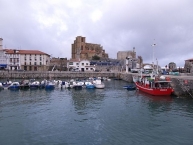
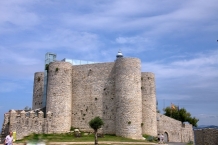
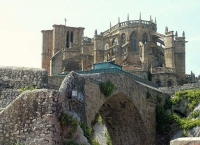
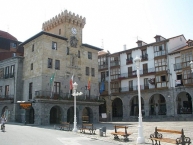
Castro Urdiales is a seaport of northern Spain, in the autonomous community of Cantabria, situated on the bay of Biscay. Castro Urdiales is a modern town, although its castle and the Gothic-style parish church of Santa María de la Asunción, date from the Middle Ages. Its chief industries are tourism, fishing, and the preservation of fish, especially sardines and anchovies, in oil. The "Lolin" and "La Castreña" anchovy canning factories serve as a reminder of the town's closeness to this industry and its proximity to the sea.
Tourism has greatly increased in Castro Urdiales in the last thirty years; many people from Bilbao and other parts of the Basque Country and Cantabria as well as Northern Spain in general keep summer homes in the town. Although the number of people registered in the town is around 32,000, the summer population can double or even triple this figure.The town is popular because of its beaches and scenic harbor. The commercial fishing industry is declining and may soon be eradicated completely.
Main sights
The monument complex of Castro Urdiales, also known as Puebla Vieja, has medieval origins and is located near the sea. It was declared a Conjunto histórico in 1978.
The Church of Santa María de la Asunción is in Gothic style. Built under the protection of King Alfonso VIII of Castile in the 13th century (though it was finished in the 15th century), it is a basilica church with three naves. In the interior are the images of the White Virgin and the Reclining Christ, and three Gothic carvings of the Magi . It was declared a National Monument in 1931.
The Castle of Santa Ana is located near the port and the church of Santa María de la Asunción. In modern times it housed a lighthouse.
Other sights include:
- Palace, castle-observatory and Ocharan gardens, protected since 1985. The castle-observatory, dating back to 1914 and designed by local architect Eladio Laredo, is in neo-Gothic style. The Ocharan Palace, or Toki-Eder, was built in 1901, also by the local architect Eladio Laredo. It is an eclectic-style building, with a portico of columns and other elements of Greek taste, and with a multicolored tile frieze designed by Daniel Zuloaga.
- Ruins of the medieval tower of the Templars, in Allendelagua, on the mountain side. It belonged to the Knights Templars and is currently in poor condition.
- Cave of El Cuco, west of the town. It houses rock carvings and paintings from the Upper Paleolithic period, which depict animals such as deers, goats and horses.
- Cave of La Lastrilla
- Cave Grande or de los Corrales
- Cave Aurelia
- Castro of la Peña de Sámano
- Remains of Flavióbriga and the medieval village, protected since 1996. The Flavióbriga archaeological site is under the Old town, two meters deep. Remains of a Roman colony can be visited in the Regional Museum of Prehistory and Archaeology of Cantabria.
- Water driving of El Chorrillo, a work of hydraulic engineering from the Roman age.
- Tower-House of Los Otañes, in Otañes.
- Ruins of the Hospital de la Vera Cruz, in Islares.
- City Hall (16th century)
- Tower-House of Cerdigo, built in Cerdigo between the 17th and 18th centuries.
- Archaeological site of Patera de Otañes, in the village of Otañe.
- Roman mile-stone, opposite the Church of Santa María. Dating to 61 AD, it marked the distance to Pisoraca
. It has an inscription that reads "Nero Claudius, son of the divine Claudius, Caesar, Augustus, Germanicus, Pontifex maximus, with the tribunician power for eighth time, the empire for ninth and the consulate for fourth. From Pisoraca one hundred and eighty miles".
- Iglesia de San Pedro (11th century), in Romanesque style.
Informationen zu Urheber-Rechten | |
|---|---|
Rechte-Ausprägung / Lizenz | by-sa: CREATIVE COMMONS Namensnennung, Weitergabe unter gleichen Bedingungen |
Link zur Rechtebeschreibung | |
Text(e) übernommen von: |
Wikipedia contributors, 'Castro Urdiales', Wikipedia, The Free Encyclopedia, 15 September 2013, 11:46 UTC, <http://en.wikipedia.org/w/index.php?title=Castro_Urdiales&oldid=573006783> [accessed 14 February 2014] |
übernommen / bearbeitet am | 14.02.2014 - 15.02.2014
|
übernommen / bearbeitet durch |
|
74 km
0,1 km
11 m
![]()
